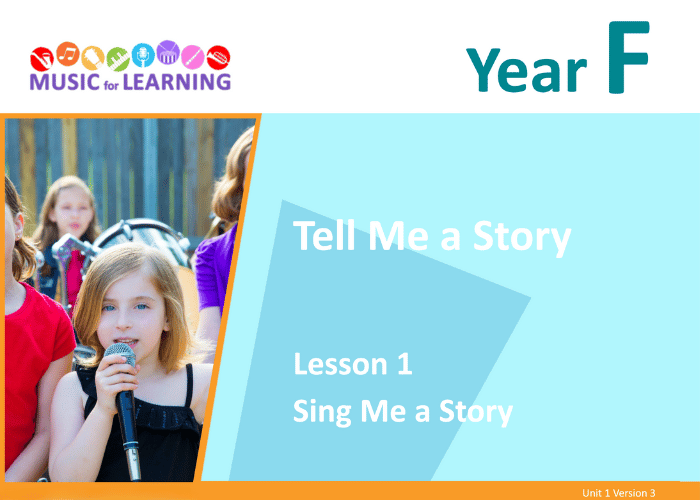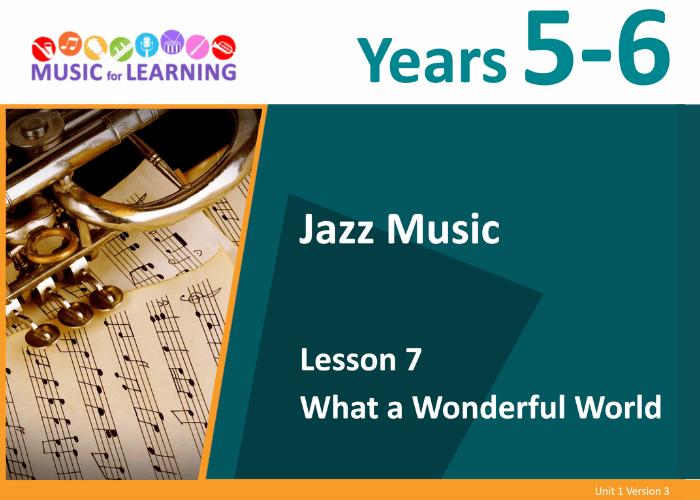Music for Learning - Unit 1: Music Resources for Primary Teachers
Music for Learning – Unit 1 provides every teacher with the confidence to deliver engaging, curriculum-aligned music lesson plans. Each lesson builds sequentially on skills, ensuring students’ progress step by step. What’s more, with structured guides, demo videos and audio support, teachers can focus on teaching while students experience engaging lessons. These resources are perfect for primary education in Australia, including ready-to-use Year 1 music lesson plans.
Why Choose Our Music For Learning Resources?
Free and Easy-to-use
Confidence for all primary teachers, with no musical background.
Curriculum V9 Aligned
Our music lesson plans cover skills across all year levels with a clear scope and sequence.
Engaging Lessons
Hands-on and active lessons using themes like travel and culture.
Save Time
Save time and boost your confidence with guides, demo video and audio support included.
🎶 Download Free Music Lessons – No Sign Up Required 🎶
At Good to Great Schools Australia, we believe every teacher deserves access to high-quality, ready-to-use music resources for primary teachers. That’s why all our resources are free for teachers across Australia.
To give you a taste of what Music For Learning Unit 1 offers, we’re giving you access to two lessons that you can download instantly – no sign-up required.
✅ Ready-to-teach music lesson plans
✅ Curriculum-aligned for primary education in Australia
✅ Easy to use, including Year 1 music lesson plans
Download free music for learning lessons today:
Music for Learning – Unit 1 (Version 3)
Foundation – Year 6
Starter Lessons
Year Overview
Foundation Year
Year F, Lesson 1

Year F, Lesson 2

Unit Overview
In the ‘Tell me a Story’ unit, students will learn how stories have been told through music throughout history and across the globe in different cultures. They will understand that not all stories have words, and some are told only through music and sound, while others have a narrator or songs with lyrics.
Students will explore their own ways of communicating stories by experimenting with musical elements (tempo, dynamics, pitch) and different ways of creating sound with voices, body percussion, ukulele and found sounds. The culminating project will be for students to work together to create a story through music.
Student Activities and Music
Music Examples and Instrumentation
Music examples:
- Toot Toot Chugga Chugga Big Red Car
- Incy Wincy Spider
- We’re Going on a Bear Hunt
- Peter and the Wolf
- The Little Train of the Caipira
- The Sorcerer’s Apprentice
- Birdsong at Dusk
- Pirates of the Caribbean Theme Song
- Where Are You from the movie Moana
- Antonio’s Voice from Encanto.
Instrumentation: percussion instruments, voice, ukulele.
Student Activities
Student activities include:
- making music for stories learned in the lessons, by singing, playing the ukulele, percussion instruments and body percussion
- listening to varied musical pieces and identifying musical elements by movement
- performing music by playing in small groups, by singing with body actions, by playing the ukulele and by using body percussion.
Features
Features
- Creative tasks that allow students to learn by doing.
- Animated slides to clearly visualise musical concepts and activities.
- Student workbook includes a drawing activity to go along with a musical story.
- Embedded demonstration videos and audio tracks.
Special Inclusions
- Musical examples feature a diverse range of genres and musicians suitable for the year level.
- Hands-on music-making activities make learning fun and impactful and encourage creativity.
- Creative, visually appealing and engaging lessons, making the learning fun and accessible.
- Musical concepts taught through various art forms create a rich and meaningful learning experience.
- Playing the ukulele as an integral part of the lessons.
Lessons, Assessment and Resources
Unit, Lesson and Assessment Information
- 9 Week Unit
- Lessons are 45 minutes and delivered once a week for nine weeks.
- Summative Assessment, Lessons 8–9: Students will demonstrate their understanding of musical elements by performing music for a story in small groups, playing the ukulele and percussion instruments.
Resources
- Lessons x9
- Instructional Teaching Guide
- Student Workbook
- Unit Overview
- Assessments/Progression Indicators
- Professional Learning Modules
Year 1 – Year 2
Years 1-2, Lesson 1
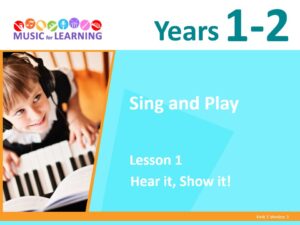
Years 1-2, Lesson 2
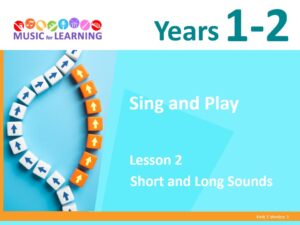
Unit Overview
In the Sing and Play unit, students will explore how their voices can bring the elements of music to life.
They will develop their understanding of key musical elements- pitch, dynamics, duration, and tempo-through both analysis and hands-on activities.
Students will also build their musicianship through performance using voice, keyboard, and body percussion.
The unit will culminate in small group presentations, where students perform the pieces they have learned.
Student Activities and Music
Music Examples and Instrumentation
Music examples:
- Do, Re Mi
- A Whole New World
- Hot Cross Buns
- Baby Shark
- Twinkle, Twinkle Little Star.
Instrumentation: Voice, body percussion and keyboard.
Student Activities
Student activities include:
- listening to varied musical pieces and identifying musical elements by movement
- performing music by singing in small groups, singing and playing the keyboard and by using body percussion.
Features
Features
- Creative tasks that allow students to learn by doing.
- Musical examples supporting every lesson.
- Animated slides to clearly visualise musical concepts and activities.
Special Inclusions
- Musical examples feature a diverse range of genres and musicians.
- Hands-on music-making activities make learning fun and impactful.
- Creative and engaging lessons, making the learning fun and accessible.
- Playing the keyboard as an integral part of the lessons.
Lessons, Assessment and Resources
Unit, Lesson and Assessment Information
- 9 Week Unit
- Lessons are 45 minutes and delivered once a week for nine weeks.
- Summative Assessment, Lessons 8–9: Students will demonstrate their understanding of musical elements by performing two songs in small groups: one by singing, and another by singing and playing the keyboard at the same time.
Resources
- Lessons x9
- Instructional Teaching Guide
- Student Workbook
- Unit Overview
- Assessments/Progression Indicators
- Professional Learning Modules
Year 3 – Year 4
Years 3-4, Lesson 1
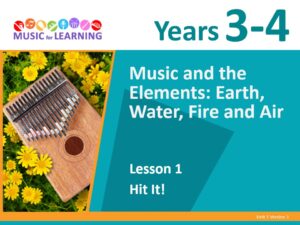
Years 3-4, Lesson 2
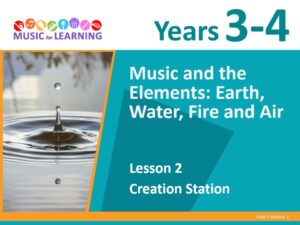
Unit Overview
In the Music and the Elements: Earth, Water, Fire and Air unit, students will explore how nature has been represented through art for hundreds of years before taking charge of their creative process to improvise and compose their own responses to nature.
They will develop knowledge and understanding of specific musical elements through analysis and practical work, as well as develop their musicianship in composition and performance on selected instrumentation (voice, percussion).
The unit will culminate in a presentation of small group performances where students perform the pieces they have created in response to one of the natural elements: Earth, Water, Fire or Air.
Student Activities and Music
Music Examples and Instrumentation
Music examples:
- ‘Naka Wara Wara To’o’, Small Island, Big Song ft. Charles Maimarosia
- ‘Bloom’, Michael Torke
- Vanuatu Women’s Water Music
- ‘Re(new)al’, Viet Cuong
- ‘Tuvan Throat Singing’, Saidash Mongush
- ‘Harmonica Beatbox’ Zipporah Temelloso
- ‘Winter Bonfire’, Sergei Prokofiev
- ‘Swamp Fire’, Duke Ellington
- ‘Bardju’, Brenda Gifford.
Instrumentation: Pitched and unpitched percussion, including homemade ‘water instruments’ and voice.
Student Activities
Student activities include:
- listening to varied musical examples and identifying the musical components that make up the music
- exploring a range of percussion instruments and vocal techniques
- using homemade ‘water instruments’ inspired by traditional music making in Vanuatu
- creating and performing music inspired by the unit’s musical examples.
Features
Features
- Creative tasks that allow students to learn by doing.
- Musical examples supporting every lesson.
- Embedded demonstration videos and audio tracks.
Special Inclusions
- Bespoke audio and video demonstrations support teaching and learning.
- Musical examples feature a diverse range of genres and musicians.
- Hands-on music-making activities make learning fun and impactful.
Lessons, Assessment and Resources
Unit, Lesson and Assessment Information
- 9 Week Unit
- Lessons are 45 minutes and delivered once a week for nine weeks.
- Summative Assessment, Lessons 8–9: Students will demonstrate their understanding of musical components by creating a group composition inspired by one of the natural elements: earth, water, fire or air. Students will make informed choices throughout the creative process and demonstrate their skills by presenting their ideas through music.
Resources
- Lessons x9
- Instructional Teaching Guide
- Student Workbook
- Unit Overview
- Assessments/Progression Indicators
- Professional Learning Modules
Year 5 – Year 6
Years 5-6, Lesson 1
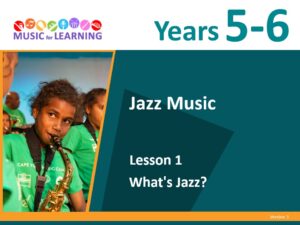
Years 5-6, Lesson 2
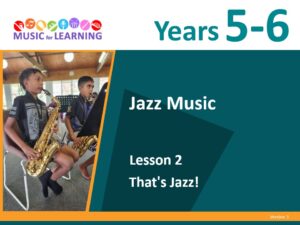
Unit Overview
In the Introduction to Jazz Music unit, students will explore the distinctive qualities of jazz music through listening, analysis and performance.
They will learn to recognise key elements that define jazz – such as rhythm, melody and expression.
Through practical activities, students will build their skills in performing jazz rhythms and melodies, while also uncovering the deeper meaning behind the music.
Student Activities and Music
Music Examples and Instrumentation
Music examples:
- In the Mood – Glen Miller
- Take Five – Dave Brubeck
- Blues in the Night – Ella Fitzgerald
- Let’s Call the Whole Thing Off – Ella Fitzgerald and Louis Armstrong
- Woodchopper’s Ball – Woody Herman
- Take the A Train – Duke Ellington
- So what – Miles Davis
- What a Wonderful World- Louis Armstrong
- St Louis Blues – Louis Armstrong
- Joy Spring – Clifford Brown and Max Roach
- Summertime – George Gershwin
- Let’s Call the Whole Thing Off – Ella Fitzgerald and Louis Armstrong
- C Jam Blues – Duke Ellington
- Take the A Train – Duke Ellington
- Summertime – George Gershwin
- What a Wonderful World – Louis Armstrong.
Instrumentation: Keyboard.
Student Activities
Student activities include:
- listening to jazz music and identifying jazz characteristics
- analysing jazz music using the elements of music
- performing jazz music using the keyboard.
Features
Features
- Creative tasks that allow students to learn by doing.
- Musical examples supporting every lesson.
- Embedded demonstration videos and audio tracks.
Special Inclusions
- Bespoke audio and video demonstrations support teaching and learning.
- Hands-on music-making activities make learning fun and impactful.
- Class set of keyboards required.
Lessons, Assessment and Resources
Unit, Lesson and Assessment Information
- 9 Week Unit
- Lessons are 45 minutes and delivered once a week for nine weeks.
- Summative Assessment, lesson 9: students will complete a performance-based assessment, demonstrating their technical and expressive skills. They will be assessed against specific performance criteria that reflect both technique and musicality.
Resources
- Lessons x9
- Instructional Teaching Guide
- Student Workbook
- Unit Overview
- Assessments/Progression Indicators
- Professional Learning Modules
- Class set of keyboards
Other Units
Lesson Design
Lesson Objective
Success Criteria
Activating Prior Knowledge
I Do
We Do
Apple Question
You Do
Revise
Don’t Just Take Our Word For It – Hear it From Teachers Like You
I’m tremendously excited about the support this gives my teachers and I can’t thank you enough for this access.
We are truly loving your resources, especially the Professional Learning modules. Our entire staff are working through these and improving their pedagogy daily as a result.
I have experience teaching music but no one else at the school does. I feel it would improve their confidence in teaching music or allow them to integrate it into other lessons, or allow relief staff to teach music when I am away.
Explore Music For Learning in Our Webinar!
Webinar: Teach Music with Confidence and grow your specialisation.
Description: Discover how the Music for Learning program helps you deliver engaging, curriculum-aligned music lessons across all primary year levels. We’ll walk you through a lesson and share practical teaching tips, prep checklists and creative ideas you can take away and apply immediately.
![]() 21 August 2025
21 August 2025
![]() 46 Minutes
46 Minutes
Looking to Strengthen Your Whole Schools Music Teaching?
Upgrade your school to a Partner School Membership for free and unlock the full potential of what Good to Great Schools offers. All your team will be able to access exclusive, high-quality resources that can make a consistent impact in every classroom.

Share this page:

